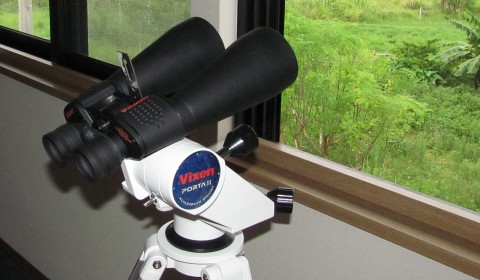Binocs Review (Preliminary)
Celestron Skymaster 15x70 (SKU 71009)
Purchase price: JPY 8,315
Dealer: KYOEI-OSAKA
Conclusion: A regret-free bargain
Please appreciate that this review reflects personal impressions and views.
Specified with multi-coated optics, this pair of binoculars offers great value for less than 80 USD, a price for which you can't grumble. It is the lowest price for binocs in its class, yet not a 'cheap' product, but a most affordable favorable combination of budget and performance, a present from heaven so to say. Of course, it does not sport ED, let alone APO lenses, but it performs surprisingly well and is especially economical for novices wishing to familiarize with astronomical observation before risking expenses for higher class optics. With a magnification of 15x, the glasses are not tailored for planets (though you can clearly resolve the Galilean moons), but rewarding for wide field views of say, Messier objects. With fold-able eye cups to use with glasses, a comfortable eye relief of 18mm and a 4.7mm exit pupil, the Skymaster provides a true angular field of 4.4° which translates into about 8.8 times the width of the full moon disk. The adjustable interpupillary distance is from 56 to 72mm, while the diopter adjustment range is from -4 to +8. The binocs are water-resistant (please do not confuse with water-proof) in a weather rejecting rubberized body. They arrived in a triple-boxed package in best condition and intact collimation.
As for all bright optics, the Skymaster 15x70 peaks its performance under dark skies with favorable atmospheric conditions. Its optics are not outstanding but surprisingly good.
'Giant' Binoculars
Often advertised as 'giant' binoculars, its aperture of 70mm (2.75") is large but not exactly giant, yet collecting abundant light with two objective lenses. Telescope owners will appreciate the binocs for viewing when persistently crossing clouds won't justify the effort of polar alignment or imaging. The Skymaster is a great instrument for group observations with friends, neighbors, children and other occasional stargazers.
'False' Colors
Color Fringing is inherent to all achromatic lenses especially around bright solar system objects. This is a quick capture through an ocular with a compact camera. The visual impression is much clearer than that. The Skymaster's circumference shows false colors but not prominent enough to feel disturbance, while the center field is contrast-rich with clear colors. The green/violet halo around the half moon cannot be overlooked but is not annoying and the overwhelmingly crisp view of the craters at the terminator will make you ignore the false colors. When aiming at the moon be sure to center it in the field of view and align your eyes with the optical axes. It does make a big difference whether you look at the moon with both eyes or with one eye through an eyepiece on a telescope. The tiny disk of bright Jupiter one month after its 2019 opposition at magnitude -2.54 outshined itself by was not washed out by false color. A magnification of 15x won't bring up cloud details anyway. The Galilean moons are beautifully resolved. Though 15x glasses are not intended for planetary views, Saturn at its 2019 opposition day shining at magnitude 1, was less than half as big as Jupiter, appearing in the view more like an oval planet. Young eyes can probably split the rings from the planet. Planets hardly take up real estate in the view of this 15x70 binocs.
Field Flatness
An achromatic lens is not corrected for flatness. When focused on the center of the field of view the circumference is blurred and vice-versa. This is not a big deal, since an object of interest is usually centered. Achromatic refractor telescopes share this optical phenomena while a parabolic Newtonian reflector mirror, too, does not bring all rays of light to the same focal point.
Other
The apparent FOV of 66° (66°/15x = 4.4° true FOV) is just right for the human eye to overlook. As a rule of thumb, binocs with 15x and higher power need a tripod when used for extended observation. Definitely, this one, too. For quick stargazing, however, the Skymaster's weight and magnification is still below the limit of endurance. All accessories that essentially belong to binoculars are included. Novices may find an optional red dot finder or equivalent pointers useful when surfing the sky for the first time. It depends on the application, but paying four times more for a twice better pair of glasses may not be worth considering.
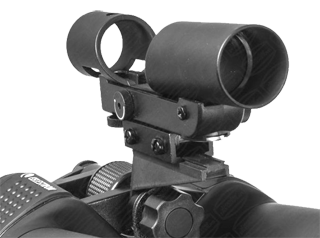 Finder (Baader Planetarium) is not bundled.
Finder (Baader Planetarium) is not bundled.
Calculated Specifications
- Relative Brightness: 21.8
- Luminosity: 9
- Apparent FOV: 66°
- Linear FOV: 77 meters
- Twilight Factor: 32.4
- Adler Index: 125
- Limiting Magnitude: 11.7
- Light Gathering Power: 100x
- Angular Resolution: 1.7 arc sec
- Star Transit Time: 70 sec
Simulated Views
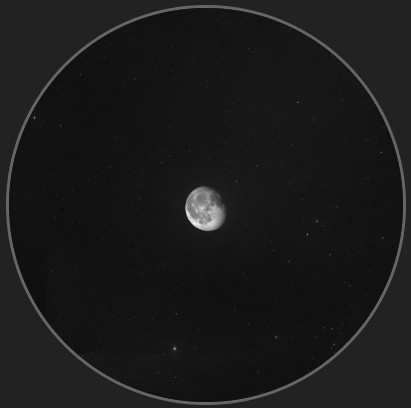 The Moon
The Moon
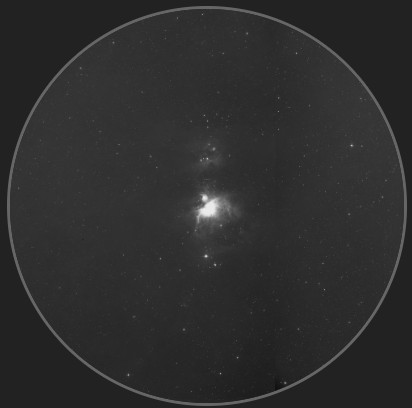 The Orion Nebula, Messier 42
The Orion Nebula, Messier 42
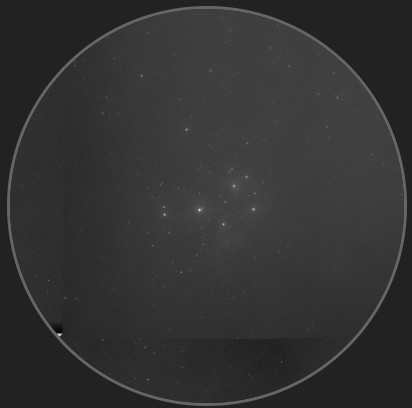 The Pleiades, Messier 45
The Pleiades, Messier 45
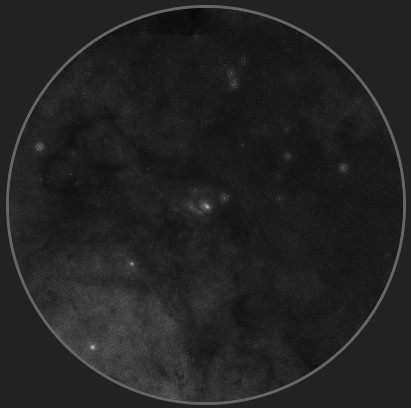 The Lagoon Nebula, Messier 8
The Lagoon Nebula, Messier 8
Pros
- Affordable, great as entry level
- Multi-coated optics, BaK-4 prisms
- Manageable size and weight (1,360gr)
- Brilliant for terrestrial use (though with little CA)
- Rough collimation possible without dismantling
- Well documented
Cons
- Known to often arrive out of collimation
- Tripod (wobble) adapter is as useful as a 1x barlow
Collimation
In order to adjust alignment (collimate) peel up the rubber grip of the right tube and turn a small slotted screw until there is only one image when you look through the glasses. If you do not peel up the grips too far, they will snap back into the original place. Doing so you may loose warranty, however, it may be way faster than returning the binos to Celestron, especially when you are not living in the United States. Video instructions can be found in the internet.
Celestron 70mm Binoculars
Each of the 70mm Skymaster series binoculars features BaK-4 prisms and multi-coated achromatic lens surfaces.
| Skymaster: | 12x70 | 15x70 | 25x70 |
|---|---|---|---|
| Magnification | 12x | 15x | 25x |
| True FOV | 4.6° | 4.4° | 2.7° |
| Exit pupil | 5.8mm | 4.7mm | 2.8mm |
| Eye relief | 19.6mm | 18mm | 13mm |
| Rel brightness | 34.03 | 22.09 | 7.84 |
| Twilight factor | 28.98 | 32.4 | 41.83 |
| Adler index | 100.4 | 125.5 | 209.2 |
| Weight | 1398gr | 1361gr | 1464gr |
www.astropical.space
Printed on 2024-05-13
No liability whatsoever assumed.

